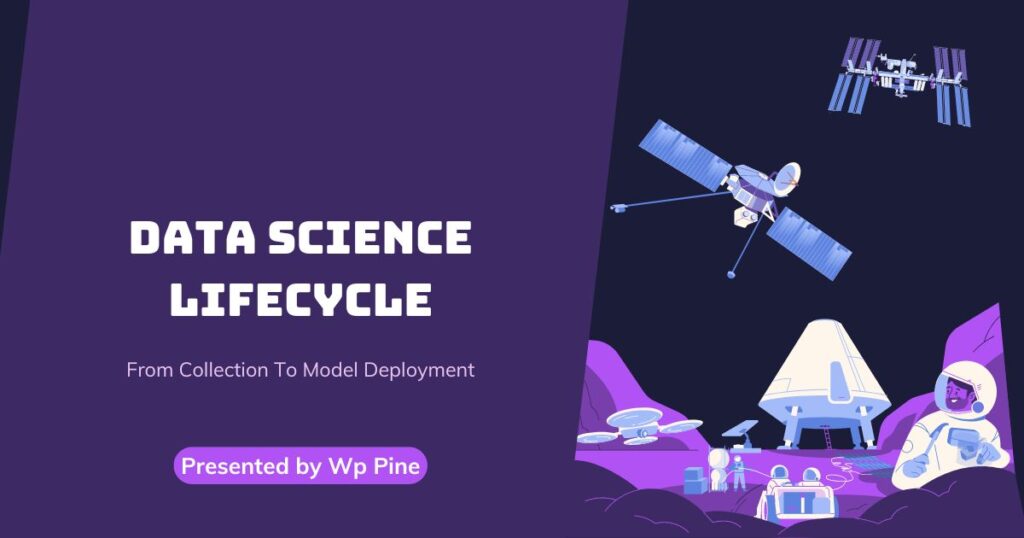The Data Science Lifecycle has become a cornerstone in modern industries, profoundly influencing various fields by driving data-driven decision-making. Understanding the intricacies of the data science lifecycle is vital for anyone aspiring to work with data. This lifecycle encompasses a series of interconnected processes, starting from data collection and preparation to model deployment, with each phase incorporating distinct methods, techniques, and standards.
This comprehensive guide aims to shed light on these critical steps, offering a detailed, step-by-step overview tailored for both beginners and seasoned professionals. From understanding data acquisition to interpreting the results of deployed models, this article equips readers with actionable insights and best practices to navigate the lifecycle effectively, ensuring successful outcomes in any data-driven project.
Data Collection
Importance of Data Collection
The initial stage of data science lifecycle in which Data is collected for the foundation of any data science project. Without accurate and relevant data, the subsequent stages of the data science lifecycle cannot be effectively executed. The quality and quantity of data collected directly impact the reliability and validity of the insights generated.
Sources of Data Collection
Data can be collected from various sources, including these steps:
- Primary Data: Collected firsthand through surveys, experiments, or direct observations.
- Secondary Data: Gathered from existing sources such as databases, reports, and online repositories.
- Web Scraping: Extracting data from websites using tools like BeautifulSoup and Scrapy.
- APIs: Accessing data from web services and platforms such as Twitter, Google, and public datasets.
Best Practices
- Define Objectives: Clearly outline the goals and objectives of the data collection process.
- Ensure Data Quality: Validate data sources and use appropriate sampling techniques to ensure data accuracy.
- Ethical Considerations: Obtain necessary permissions and ensure compliance with data privacy regulations.
Data Cleaning and Preparation
Importance of Data Cleaning
The 2nd step of the data science lifecycle is Data Cleaning. The Raw data often contains errors, inconsistencies, and missing values that can negatively impact analysis. Data cleaning is the process of identifying and rectifying these issues to ensure data integrity.
Common Data Cleaning Techniques Used in Data Science Lifecycle
- Handling Missing Values: Imputation, deletion, or using algorithms that handle missing data.
- Removing Duplicates: Identifying and removing duplicate records to avoid skewed analysis.
- Correcting Inconsistencies: Standardizing data formats and correcting or removing typographical errors.
- Data Transformation: Normalizing or scaling data to ensure uniformity.
Best Practices
- Use Automated Tools: Leverage tools and libraries like Pandas, OpenRefine, and Trifacta for efficient data cleaning.
- Document Changes: Maintain a record of all cleaning and transformation steps for reproducibility.
- Iterative Process: Data cleaning should be an iterative process, revisited as new data is collected or new issues are identified.
Exploratory Data Analysis (EDA)
Importance of EDA
EDA is the 3rd step in the data science lifecycle and it is the most important part, it involves summarizing and visualizing data to understand its structure, patterns, and relationships. It helps in identifying anomalies, testing hypotheses, and selecting appropriate modeling techniques.
Key EDA Techniques
- Descriptive Statistics: Calculating mean, median, mode, standard deviation, and other summary statistics.
- Data Visualization: Creating plots and charts using libraries like Matplotlib, Seaborn, and Plotly.
- Correlation Analysis: Identifying relationships between variables using correlation coefficients and heatmaps.
Best Practices
- Use Visualizations: Visualize data to gain intuitive insights and communicate findings effectively.
- Explore All Angles: Examine data from different perspectives to uncover hidden patterns.
- Document Findings: Keep detailed notes on observations and insights gained during EDA.
Feature Engineering
Importance of Feature Engineering
After the EDA 4th step of the data science lifecycle is Feature engineering which involves creating new features or modifying existing ones to improve model performance. It is a crucial step in the data science lifecycle, as the quality of features directly impacts the model’s predictive power.
Common Techniques Used in Data Science Lifecycle
- Feature Creation: Generating new features based on domain knowledge and data patterns.
- Feature Transformation: Applying mathematical transformations such as logarithms, square roots, and polynomial expansions.
- Encoding Categorical Variables: Converting categorical variables into numerical formats using techniques like one-hot encoding and label encoding.
- Feature Selection: Identifying and selecting the most relevant features using methods like correlation analysis, mutual information, and recursive feature elimination.
Best Practices
- Leverage Domain Knowledge: Use insights from subject matter experts to create meaningful features.
- Automate Feature Engineering: Utilize tools like FeatureTools and libraries like Scikit-Learn for automated feature engineering.
- Evaluate Feature Impact: Continuously assess the impact of engineered features on model performance.
Model Selection and Training
Importance of Model Selection
In the data science lifecycle it the critical to choose the right model for achieving accurate predictions and meaningful insights. The choice of model depends on the nature of the problem (e.g., classification, regression, clustering) and the characteristics of the data.
Common Machine Learning Models
- Linear Regression: Used for predicting continuous outcomes.
- Logistic Regression: Suitable for binary classification problems.
- Decision Trees and Random Forests: Versatile models for both classification and regression tasks.
- Support Vector Machines (SVM): Effective for high-dimensional data and classification tasks.
- Neural Networks: Powerful models for complex problems, especially those involving large datasets and intricate patterns.
Model Training in Data Science Lifecycle
Model training involves fitting the chosen model to the training data.
This step includes:
- Splitting Data: Dividing data into training and testing sets to evaluate model performance.
- Hyperparameter Tuning: Optimizing model parameters using techniques like grid search and random search.
- Cross-Validation: Using techniques like k-fold cross-validation to assess model robustness.
Best Practices
- Use Multiple Models: Experiment with different models to identify the best-performing one.
- Optimize Hyperparameters: Invest time in hyperparameter tuning to enhance model performance.
- Avoid Overfitting: Use regularization techniques and cross-validation to prevent overfitting.
Model Evaluation
Importance of Model Evaluation in Data Science Lifecycle
After choosing the right model in the data science lifecycle, Now it’s to Evaluate the model performance to ensure that the model generalizes well to new data. It helps in identifying potential issues and areas for improvement.
Common Evaluation Metrics
- Accuracy: The proportion of correctly predicted instances out of the total instances.
- Precision and Recall: Metrics for evaluating classification models, particularly in imbalanced datasets.
- F1 Score: The harmonic mean of precision and recall, providing a single metric for model performance.
- Mean Absolute Error (MAE) and Mean Squared Error (MSE): Metrics for assessing regression models.
- ROC Curve and AUC: Tools for evaluating the performance of binary classifiers.
Best Practices
- Use Appropriate Metrics: Select evaluation metrics that align with the problem and business objectives.
- Perform Error Analysis: Analyze misclassified instances to understand model weaknesses and areas for improvement.
- Visualize Performance: Use plots and charts to visualize model performance and communicate results effectively.
Model Deployment
Importance of Model Deployment in Data Science Lifecycle
Model deployment is part of the data science lifecycle which involves integrating the trained model into a production environment to make real-time predictions or support decision-making. It is the final step in the data science lifecycle, enabling the practical application of the model.
Deployment Strategies
- Batch Processing: Processing data in batches at scheduled intervals.
- Real-Time Processing: Making predictions in real-time using APIs or streaming platforms.
- Hybrid Approaches: Combining batch and real-time processing based on the use case.
Tools and Technologies
- Cloud Platforms: AWS, Google Cloud, and Azure offer services for deploying and managing machine learning models.
- Containerization: Using Docker and Kubernetes for packaging and deploying models in a scalable and reproducible manner.
- Model Serving: Tools like TensorFlow Serving, TorchServe, and FastAPI for serving models as APIs.
Best Practices
- Ensure Scalability: Design deployment pipelines to handle varying loads and scale as needed.
- Monitor Performance: Continuously monitor model performance and retrain models as new data becomes available.
- Implement Version Control: Use version control for models and deployment scripts to track changes and ensure reproducibility.
Monitoring and Maintenance
Importance of Monitoring
Once a model is deployed in the data science lifecycle, it is essential to monitor its performance continuously. Over time, the model’s accuracy may degrade due to changes in the underlying data patterns or external factors. Regular monitoring helps identify when a model needs retraining or adjustment.
Monitoring Techniques
- Performance Metrics: Track key metrics such as accuracy, precision, recall, and F1 score over time.
- Drift Detection: Identify changes in data distribution using statistical tests and drift detection algorithms.
- Alert Systems: Set up automated alerts to notify when performance metrics fall below a predefined threshold.
Maintenance Practices
- Scheduled Retraining: Periodically retrain models with new data to maintain accuracy and relevance.
- Model Versioning: Keep track of different model versions and ensure the ability to roll back to previous versions if necessary.
- Documentation: Maintain comprehensive documentation of model changes, performance metrics, and monitoring results.
Ethical Considerations and Governance
Importance of Ethics in Data Science Lifecycle
Ethical considerations are paramount in the data science lifecycle, especially when models impact human lives and societal outcomes. Ensuring fairness, transparency, and accountability in data science practices is crucial.
Ethical Practices
- Bias Mitigation: Implement techniques to detect and reduce bias in data and models.
- Transparency: Ensure that model decisions are explainable and understandable to stakeholders.
- Privacy Protection: Comply with data privacy regulations and implement measures to protect sensitive information.
Governance Frameworks
- Ethics Committees: Establish committees to oversee data science projects and ensure ethical practices.
- Auditing and Compliance: Regularly audit data science processes and models for compliance with ethical standards and regulations.
- Stakeholder Engagement: Involve diverse stakeholders in the development and evaluation of data science projects to ensure a holistic perspective.
Future Trends in the Data Science Lifecycle
Emerging Technologies
- AutoML: Automated machine learning platforms that streamline model selection, training, and deployment.
- Federated Learning: Collaborative machine learning without sharing raw data, enhancing privacy and security.
- Explainable AI (XAI): Techniques and tools to make AI models more interpretable and transparent.
Evolving Practices
- MLOps: Integrating machine learning with DevOps practices for efficient and scalable model deployment and management.
- DataOps: Focusing on data engineering, integration, and governance to support data-driven workflows.
- Ethical AI: Increasing emphasis on developing and deploying AI systems that are fair, accountable, and transparent.
Conclusion
The data science cycle is a process that starts from raw data and ends with the delivery of analysis outputs and models for prediction. All stages, starting from data gathering and ending with model implementation, contain a set of approaches and recommendations for data science initiatives. Thus, by gaining control over these above-defined stages, data scientists can learn more about the data under their considerations and apply them across numerous domains.
Every data scientist, no matter whether they are a novice or a more experienced, should recognize and implement the data science lifecycle as an instrument to operate within the environment of this rather intricate and constantly evolving field. Therefore, if you apply the guidelines pointed out in this article, you will be in a position to implement good reliable data science solutions that can have significant value.
Data science has a bright future since people are constantly improving technology and incorporating new practices in data science. By staying updated with the current trends and knowledge of the best practice a data scientist will be in a position to serve this noble discipline at par with current developments.
Additional Resources
Dive deeper into the data science lifecycle, practice with real datasets, and continue expanding your knowledge. Share this guide with others and leave your thoughts or questions in the comments!
For further reading on Data Science lifecycle, best practices, and tools, consider exploring the following resources:
- Learn data science from AWS Amazon
- Learn data science from IBM
- Data Science Made Easy by Wppine
- 10 Best Tools for Data Scientists by Wppine
- Learn about Big Data by Wppine



